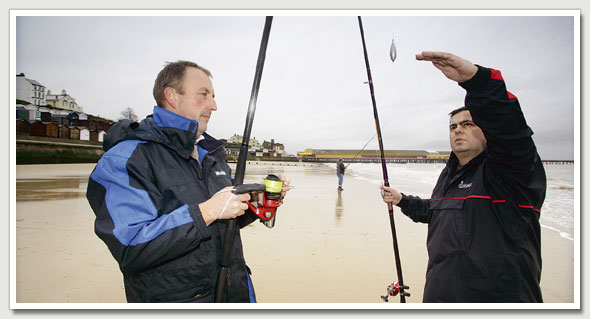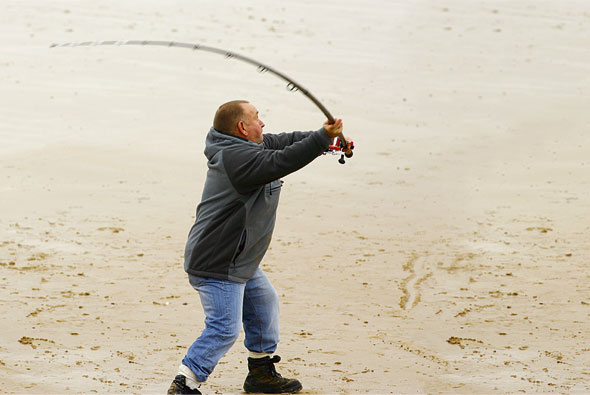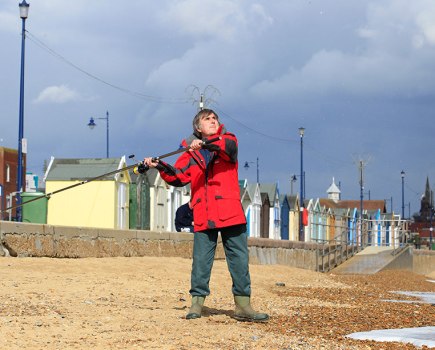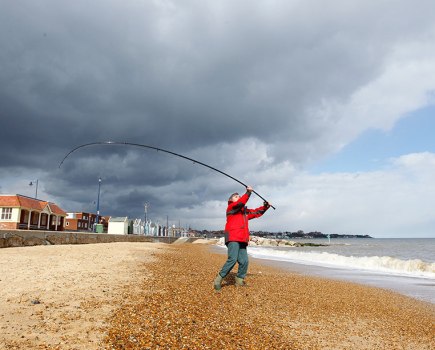Mark and Gary Poole were hooked on pendulum casting from the moment they saw Richard Holgate’s baits fly way out to sea. Like most top anglers in the area, Richard considers pendulum casting the best way to catch fish from the shallow beaches of Essex, Suffolk and beyond.
Pendulum casting was born and raised on the beaches of East Anglia. Its bloodline is a fusion of casting and fishing. It is not, and never was, a pure tournament style…it was developed to deliver cod baits big distances and was spawned out of a necessity.
There is something special about swinging the lead that tempts and tortures in equal measure. For every fisherman who masters pendulum casting, a dozen fail. The trek from first hesitant swing to majestic, full-flowing pendulum is long and demanding for even the most talented.
For many, the Full Monty is an impossible dream. So in these days of ultra-long rods and out-of-the-can expertise – meaning thump it as hard as you can and let technology do the rest – why would Mark and Gary bother trying to learn?
Mark discovered one big advantage the first time he fished with Richard. He baited up, clipped down the hooks and laid the lead weight on the beach to cast. The baits came unclipped the moment the leader went slack.
Crafty tactics or PVA string can overcome ground casting’s defects, but swinging the lead – thus keeping rig and leader under tension – is the professional way to do it.
Besides, ground casting is difficult from many of the best fishing spots in the area. A pendulum swing guarantees a clean launch even if you’re fishing on a narrow esplanade with your back to a beach hut. A short rod used with a modest drop and abbreviated swing needs less space than a long rod powered by a mighty thump.
To appreciate the full appeal of pendulum casting, it’s necessary to understand that the cast itself is part of a complete system of fishing. After 40 years of experiment and refinement, the cast itself and the tackle to do it are honed close to perfection.
For example, the 12ft Flick Tip Richard Holgate uses much of the time is rooted in the massively successful Cono-flex Cod glass and semi-carbon rods of yesteryear, which themselves were inspired by the revolutionary Abu 464.
Materials may have altered, boosting performance along the way, but the key features remain: shortish, quickish, adequately stiff low down, nicely sensitive at the top. Such rods wind up easily, throw a long way, keep the baits on and handle the fishing side of things beautifully. Reels, lines and rigs are closely matched to the rod.
The result is a highly effective long-range package arguably without equal in the history of beach fishing. You need look no further than Richard’s impressive track record to see proof of that. Put simply, this style has been catching fish and winning matches year in, year out since the late 1960s. Can there be a more compelling reason for Mark and Gary to accept the pendulum challenge?

GETTING INTO THE SWING OF THINGS
RICHARD’S off-ground method, which we looked at last time, is designed so that the swing can be added easily. Only the first part of the cast changes; the power arc is virtually the same whether the cast begins with the lead sitting on the beach or hovering in mid-air.
The beauty of off-ground casting is that when things go wrong with their embryo pendulum style – as they will – the Poole brothers have a solid off-ground foundation to fall back on.
Without that safety net there is a strong chance that problems in the swing may spread to infect the power arc as well.
Should things turn wobbly, one or two ground casts will get them back in the right groove. Beginners often find that alternating between off-ground and pendulum casts is excellent practice anyway.
Had you dropped in on their lesson, you may have been surprised by the lack of detailed instruction. Richard dispenses with theory and cuts straight to the chase. “Swing the lead out, then bring it back on the inside. As the lead reaches the top of its inswing, unwind your body and cast, just as you do off the ground,” he urges.
Setting the sinker drop to a shade over two metres, he swung the 150g lead through a gentle outward-then-inward arc, turned and swept the cast seaward. “Now you do it.” Which they did…more or less.
More or less is good enough to begin with. It takes a while to get used to pendulum work, mainly because it is so different from the thumping style with which 99 per cent of beach anglers begin their career.
Early attempts to cast with a swinging lead are mostly about coming to terms with an alien concept. To add to the joy of it, pendulum casting has a couple of nasty traps for the newcomer. Almost everyone gets caught.
How do you make the lead swing? Accuracy and rhythm are not the issue at this stage. The headache is how to make the damn thing swing at all. As Richard demonstrated, powering the swing is easy when you know how. Simple technique and plenty of confidence are the key ingredients.
Stance, body wind-up and rod angle remain the same as for ground casting. They’ll alter in time as technique matures, but to begin with the Poole boys should work on the old foundations.
Next is sinker-drop. As a rough guide, it should be about two-thirds of the rod length. Experiment a little to find a length of drop that seems to suit, then stick with it for a while. Leave the finetuning until later.
GO ON, GET RECKLESS
WITH these basics explained Richard moved on to the swing, which starts with the rod almost vertical and the sinker a little above eye level. In this compact form of pendulum casting, the outswing is created by a firm push of the right hand.
When the lead weight reaches its peak, a downward push of the left hand, plus a hint of right hand lift, bring the lead back to form the inswing. If the sequence goes wrong at any stage, stop and start again.
Richard’s everyday style with its abbreviated swing delivers all the distance he needs with a Flick Tip rod and 150g tackle. Having seen him in action, the boys already understand that a well crafted but restrained swing is more than adequate most of the time, demands nothing exotic in the way of tackle, and is just about as effortless as long range casting can be.
The boys need to keep reminding themselves that a simple style done well outguns a poorly controlled mighty swing. Biting off more drop, swing speed and body rotation than they can chew would be the quickest route to pendulum hell.
The second common problem is to lose confidence and bottle out when the lead reaches maximum height on the inswing. This point in the swing should trigger a smooth, relaxed transition into the main part of the cast during which the rod and lead must trace a path that flows down and around before accelerating up and away. Instead, the caster panics, snatches at the rod, completely loses the power arc and ends up making the dreaded overhead thump. More care and control would seem to be the logical cure. In fact, it usually pays to get reckless.
The flattish, rotary action that Richard taught the boys helps to avoid this serious error which pendulum experts call ‘cutting the corner’. Body rotation naturally produces wide arcs and a long acceleration path for the sinker.
Timing is far less critical; a rotary path also self-corrects for quite big mistakes by bringing the caster, lead and rod into the proper relationship with each other as power and speed build up. The result is a lazy-looking action that generates an awful lot of power – and gets clean away with errors that may otherwise have exploded the reel.
By the end of the session Mark and Gary were doing quite nicely. Their casting was inevitably ragged and inconsistent, but already you could see the right shapes and rhythms starting to gel. Under Richard’s guidance they are on track towards the beginnings of a technique capable of being developed into the full pendulum swing.
Technically, these advanced, powerpacked pendulum styles are just an extension of the compact version. The power source is the same throughout: body rotation, the athletic motive force that drives discus, shot and hammer throwing.
But for now the target is a comfortable fishing range of 125 metre or more. If they work at it, they’ll be there sooner than they think.

1. With the rod almost vertical and sinker a little above eye level, push the right hand to create the outswing
2. After the lead reaches maximum height on the inswing, the rod and lead trace a path down and around…
3. …before accelerating up and away. Body rotation naturally produces wide arcs and a long acceleration path for the sinker
4. The rotary path allows power and speed to build up, giving a lazy-looking action that generates lots of power before you release the line
KEY STEPS IN PENDULUM CASTING
- Use a rod that you can bend easily – not too stiff, not too long.
- Work comfortably within your limits.
- Learn to control the swing process.
- If the swing is somewhere on plane and high enough to allow time for the power arc to begin, it will do for now. Perfection comes later…or never.
- Timidity kills pendulum casting. Better to be reckless.
- Build on simple, solid foundations.
- Stick to the basics until you’re confident.
- Then explore the possibilities.
- Aim to be the best caster you can be, but accept your limitations.
- Commit yourself to putting in the necessary time and effort.







